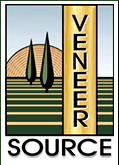







Veneer production has been known for more than 4000 years
The "inventors" of veneer were the Egyptians
- Wood was a very scarce raw material
- It was especially valued for its aesthetic qualities
- The Egyptians strove for maximum utilization of wood
- Logs were sawn into very thin boards
Beginning of the 19th century, new processing methods were developed
- Sawing was replaced by slicing with knives instead of saw blades
- "Peeling" of logs with machines
- New production techniques slowly gained acceptance
Veneer production has developed into an industry since the 1950s
- Manual production disappeared
- Market entrance barriers increased due to increased capital intensity
Veneer opens a whole new world of woodworking to even the most experienced craftsperson. With an exotic veneer, simple projects can be turned into works of art. In fact, a highly figured veneer can often be the qualifying characteristic that makes one project stand well above the rest. Veneer gives you a unique opportunity to work with some of the most beautiful and exotic woods in the world without having to dip into your retirement account.
Wood veneer has several distinct advantages over solid lumber that can't be overlooked. It is these advantages that have brought the art of veneering into most professional cabinet and furniture shops. The good news is that with the right tools, veneering is relatively easy and it's now becoming a mainstream technique used by weekend warriors to turn even the most mundane projects into heirloom quality masterpieces.
The True Beauty of Veneer
Stability - Some species of wood are simply unstable in lumber form. The unorganized grain in burl wood is beautiful but horribly prone to warping and splitting. By slicing a burl into veneer, wood movement is kept under control by the adhesive and substrate. Even the most unruly woods can be sliced into veneer and used to make a stunning, yet stable panel.
Economy & Availability - Many wood species are so rare and valuable that in lumber form, are simply unaffordable. There's a marked scarcity of fine logs available world-wide. Couple this with the idea that there is an ever-increasing demand for fine wood and you have a formula for a log that is worth ten times what it was 5 years ago. By slicing a log into veneer, the square foot of "face" material is increased by over 4,000% and a new economy is created for these forest products.
This increase in value is certainly not limited to straight grain wood. Figured wood is subjected to almost unimaginable increases in value and as these logs are sliced and exported, wood users are going to see prices rise, quality drop, and large sizes become extreme rare.
Practicality - If you've ever seen a classic serpentine dresser, you probably understand the practicality of using veneer for curved work. But it's certainly not limited to fancy projects. Oak, cherry, walnut, and other hardwood plywood are more than just practical. They're often considered indispensable for many woodworking projects.
... that managed forests, thanks to their high proportion of young, strong, growing trees, enable CO2 to be extracted?
... that an old, unmanaged forest produces as much CO2 through processes of decomposition and decay as it stores, and that therefore an unmanaged forest contributes nothing to reducing global CO2?


Phone: 407-423-2252 • Fax: 407-423-1566 • sales@veneersource.com